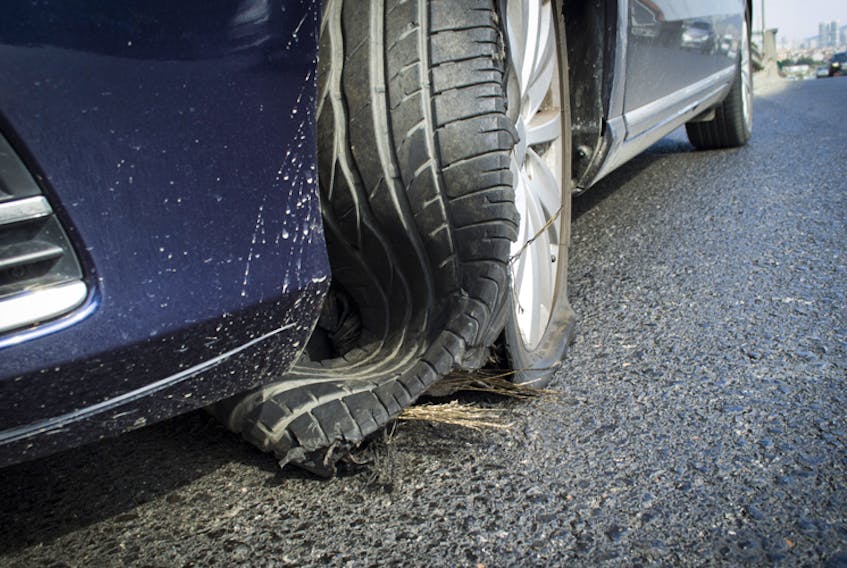Bang, whop, whop, whop. That is what it might sound like when a tire blows..
In addition to the sound there will be a sudden vibration through the steering wheel if it is front tire and through the seat if a rear tire blows.
What to do?
Tire failure can occur gradually, from a slow leak or rapidly when punctured or torn apart by striking a large sharp object such as a curb or deep pothole.
Regardless of the cause, the procedure is the same.
A blown front tire will generally cause the vehicle to pull in the direction of the collapsed tire.
The pull will be more severe if a front tire and the rear of the vehicle will become very “loose” if a rear tire blows.
If you experience tire failure, do not panic.
Be smooth.
No sudden inputs of brakes or steering.
Ease off the gas, grip the steering wheel firmly with both hands and very slowly apply some braking.
Activate the four-way flashers to alert other motorists you are worthy of their attention and start a visual search of your surroundings.
Look way down the road for the best possible spot to pull way off — a couple of vehicle widths off the road.
Continue to reduce speed and once you are down to a crawl, pull as far to the right as possible, unto the shoulder if there is no sharp drop off.
Once you reach a spot where you can pull well off, do so, call for assistance or change the tire.
In some cases it is possible to follow a piece of guardrail to its end and then pull off and reverse back in behind the guardrail. If you are prevented from pulling off the road, as may be the case on a long bridge for example — drive slowly with your flashers on and as far to the right as you can until it is safe to pull off.
If the tire comes apart at this speed — less than 10 km/h — it will do little damage to the vehicle; the wheel or rim may become damaged but all of these pieces are replaceable.
You are not safe stopping on the road under these conditions even if you stay in the vehicle because following motorists may not be paying attention and could smash into the rear of your vehicle at speed. Get off the road if at all possible.
Obviously, if you are in an area where it is not safe for any reason to get out of the vehicle, do not. If you have a cell phone, use it to call for assistance.
Avoid the urge to jam on the brakes. As the vehicle slows and you are sure you have total control, gradually apply some braking.
There are three potential problems during this action — all relate to panic and acting too suddenly:
1. If you release the gas pedal very quickly, you transfer a lot of weight to the front of the vehicle suddenly, if a front tire has blown and the remaining front tire is doing all the work that that extra load may be too much for it, causing it to lose grip.
2. Yanking at the wheel suddenly, trying to get to the side of the road. Here, it doesn’t matter whether a front or rear tire has blown; the sudden lateral weight transfer can create a problem for the remaining tire on that end of the vehicle.
3. Jumping on the brakes. Once again, it doesn’t matter whether it is a front or rear tire that has blown; this action will place added stress on all four tires. If a front tire has blown the rapid weight transfer will place more load on the lone tire that you’ll need to steer the vehicle. If your vehicle has ABS it will attempt to adjust for the different levels of grip, but it is still wise to apply brake pressure slowly.
Once a tire has lost pressure, it collapses on the rim and is pretty much worthless with respect to gripping the road. Driving very far on that collapsed tire will cause it to tear apart, flying into pieces.
We’ve all seen what happens to large truck tires when that happens — pieces fly everywhere. The same thing happens with a passenger vehicle tire; it is just that the pieces are smaller.
The remaining pieces of tire can flail around inside the wheel well causing some considerable damage and there is the potential of these rapidly thrashing pieces with metal embedded in them slashing a brake or electrical line.
Pull off the road as soon as it is safe to do so.









